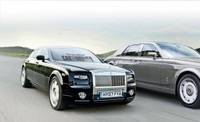2010 Rolls Royce RR4
2010 Rolls Royce RR4
By Carey Russ
Never a dull moment in this business. I got an email a week ago asking if I would care to drive to Los Gatos, California, in order to drive some Rolls Royces and see a presentation of a future Rolls product. It was about an hour's drive from home, and I needed to put miles on the week's test car (an appropriate BMW X5 turbodiesel) so why not?
Rolls Royces are not part of the normal press fleet mix - for anyone. It's not like they're mass-produced, in any sense of that term. A few hundred a year make it to the US, with no incentives needed for sale. At a starting price of around $400,000, a Rolls is worth more than my house, even at the top of the overvalued housing boom...
And realistically, over a certain point -- say around $40,000 these days -- any real improvements in materials, build quality, or anything other than pure status-symbol pose value become insignificant. Above that threshold, with mass-produced vehicles, it's all about status. Other animals may grow their mating and dominance plumage; humans buy theirs....
And a Rolls is perhaps the best-known four-wheeled status symbol on the planet. But how is it as a car?
Quick historic background: Rolls-Royce was founded over 100 years ago in England by Henry Royce and C.S. Rolls. The company soon had a reputation for building the finest cars in the world, thanks to its 40/50hp Silver Ghost model. Between 1921 and 1931, Rolls-Royces were also built in Springfield, MA. Also in 1931, Rolls-Royce acquired rival Bentley. From 1914, Rolls-Royce also built aircraft engines, perhaps the most famous of which was the Merlin V12, used to power the P-51 Mustang among other airplanes.
Rolls eventually also built jet engines, and it was costs incurred in development of the RB211 that led to nationalization in 1971. In 1973, the car and aviation parts of the company were separated, and returned to private ownership. In 1998, Vickers, which owned the automobile part of Rolls, decided to sell. After a bidding war between BMW and Volkswagen Group, VW won -- but Rolls-Royce plc, the aviation ex-division, which had working agreements with BMW (whose engines were also used in the Rolls-Royce and Bentley cars of the time), licensed trademarks including the name and logo to BMW. VW had rights to the grille shape and "Spirit of Ecstasy" ornamental mascot, but not the name...
A deal was struck between VW and BMW, and from 1998 through 2002, both Rolls-Royce and Bentley automobiles were built at the Crewe factory and used BMW engines. From the beginning of 2003, Bentleys continued to be built at Crewe, with VW Group-derived power, and Rolls-Royce production was transferred to a new plant in Goodwood, near the famous race track.
Engines used in the current Rolls-Royce line are supplied by BMW, but considerably modified by Rolls-Royce. The current model range consists of variations on the Phantom theme, in sedan, coupe (that's pronounced cou-pay at this level...) and drophead coupe (British for convertible) themes. Interior options and accoutrements are, to use the proper British terminology, bespoke. Meaning each Rolls-Royce is largely custom-built to the specification of its owner.
After a short presentation on an upcoming smaller Rolls-Royce, assembled journalists were turned over to product specialists who instructed us on the available cars. A sedan, coupe, and convertible were available to ride in, and to drive.
Comments: I'm a sucker for anything Art Deco, and so apparently are the Rolls-Royce interior designers. If God is in the details, God is riding in a Rolls-Royce.
Suddenly a Mercedes-Benz or BMW or Audi is merely a taxicab. A Lexus LS is only a pretentious Toyota. The materials and build quality in a Rolls are truly a class or two above what is found even in the best of those essentially middle-class marques.
 |
The Phantom chassis is an aluminum space frame, with non-load bearing body panels. So a variety of materials, finishes, and shapes may be used for the body. Stainless steel seems popular here.
 |
Yes, a Rolls, even the "small" coupe, is an immense vehicle. Nearly 6,000 pounds of immense vehicle. And it's relatively softly-sprung, but with excellent damping (of course) so it tracks true and stable. Power is from a 6.7-liter V12, a stroked and otherwise massaged version of that found in a BMW 7-Series, producing 453 horsepower and 531 lb-ft of torque.
 |
Then to the rear seat of the Phantom sedan. Real wool carpeting -- and thick sheepskin mats in this one. Mind if I take my shoes and socks off? mmmmm! Oh yes, spacious? Indeed. The very definition of. And the burled wood tray tables make those in some Jaguars look rather deficient. Where's the Grey Poupon?
 |
It was an interesting afternoon, and instructive. I had gone into this expecting to be unimpressed. Expecting that the cars would not live up to the legend and the hype. As it should be, a Rolls-Royce is not a normal motorcar. The legend does indeed have a solid basis in fact. My inner cynic came out defeated. My inner plutocrat, however, was quite pleased. Quite...



